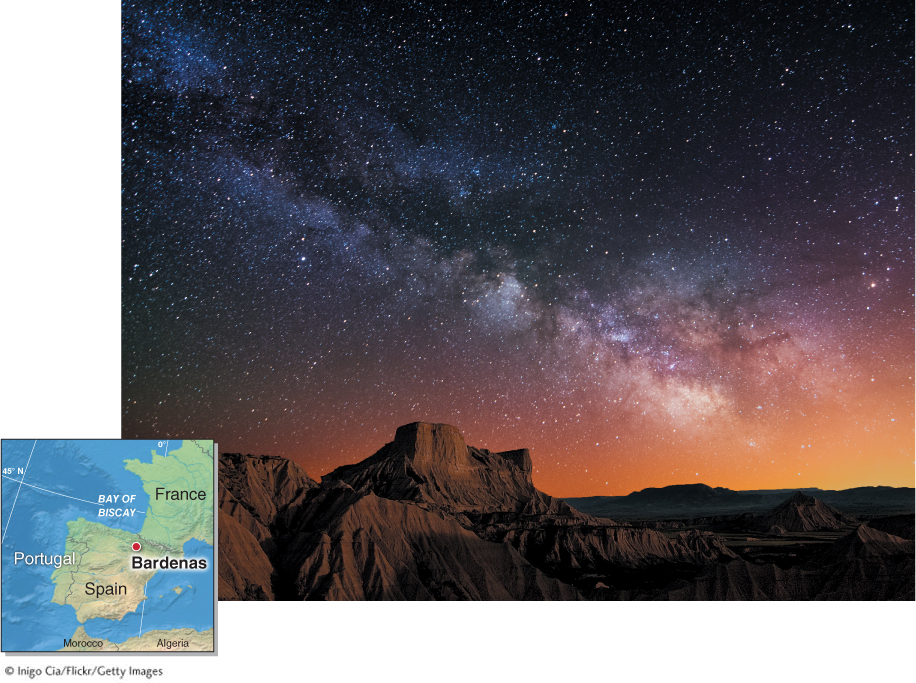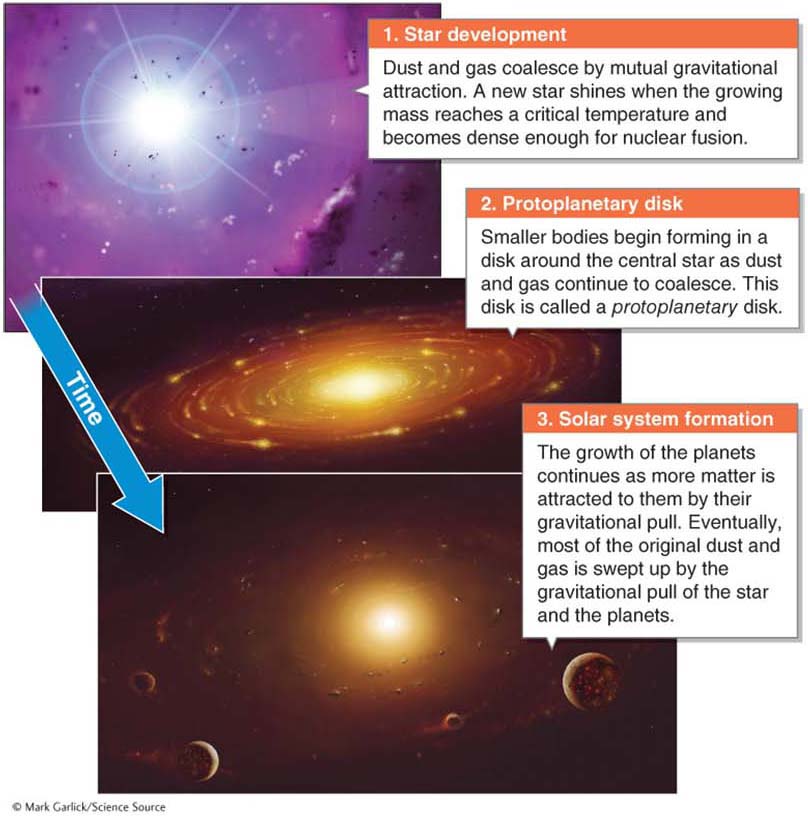11.1 Earth Formation
Explain the origin of Earth and its atmosphere and oceans.
Earth is one of eight planets in our solar system. Our solar system includes the Sun and all objects orbiting the Sun, including hundreds of thousands of rocky asteroids and icy comets as well as the eight planets. Earth’s solar system is not the only solar system in existence, however. So far, astronomers have discovered nearly two thousand planets outside our own solar system, and nearly 800 other solar systems. About three new planets are discovered every week.
Solar systems are found in galaxies. The Milky Way galaxy is the galaxy in which Earth resides. Galaxies are organized, rotating masses of hundreds of billions of stars. Scientists estimate that there are some 100 billion to 400 billion stars in the Milky Way and about the same number of planets. When we are away from city lights and under clear skies, the Milky Way is visible to us as a band of stars in the night sky (Figure 11.2).

Galaxies are immensely large, and the distances between them are vast. The Milky Way, for example, is 120,000 light-
The Milky Way and Andromeda galaxies are two among many hundreds of billions of galaxies in the universe. Scientists’ understanding of the universe is incomplete and evolving. Astronomers think that atoms (and molecules) that make up physical matter constitute only about 4% of the mass of the universe. The rest of its mass may be composed of dark energy, which may constitute 74% of the universe’s mass, and dark matter, which may make up 22% of its mass.
The universe began about 13.8 billion years ago. This age estimate is based on astronomer Edwin Hubble’s observation that galaxies and other objects are all moving away from Earth and from one another. From this observation, Hubble surmised that the universe is expanding, an idea called the expanding universe theory. From the rate of their movement, Hubble and other astronomers calculated that all the galaxies would have been at a single point about 13.8 billion years ago. At that time, that single point exploded in the Big Bang. Since then, the universe has been expanding.
Formation of Stars and Planets
A star is formed as a cloud of dust and gas in space, called a nebula, coalesces by mutual gravitational attraction and collapses. As the mass of this protostar increases, its internal pressure and temperature rise through gravitational compression. Eventually, as more and more material is accumulated, the object’s interior temperature reaches about 10 million °C (18 million °F). At this temperature, hydrogen atoms fuse to form helium. Enormous amounts of heat and light are produced by this nuclear fusion.
How did Earth form?
Like the Sun and the other planets, Earth formed 4.6 billion years ago as dust and gas in space coalesced. All matter on Earth is derived from this dust and gas.
Not all the dust and gas in a nebula coalesces into the growing star. It also coalesces into smaller bodies that are not massive enough to trigger nuclear fusion, resulting in the formation of planets, asteroids, and other objects (Figure 11.3). Our solar system and everything in it, including Earth, is formed from the coalescence of dust and gas about 4.6 billion years ago.
The Sun is 333,000 times the mass of Earth, and about 1 million Earths would fit inside the volume of the Sun. The mass of the Sun exerts a strong gravitational pull that keeps the planets locked in their respective orbits along a flat plane (Figure 11.4). Earth is the third closest planet to the Sun; Venus and Mars are its two nearest neighbors.

Most of the planets in the solar system have orbiting satellites, or moons. The leading hypothesis to account for the formation of Earth’s Moon states that another planet in the solar system collided with Earth about 4.5 billion years ago. That other planet, called Theia, is thought to have been about two-
Earth has been pounded by large asteroids throughout its history. During the Late Heavy Bombardment, in the early history of the solar system, this type of collision was common. So many asteroids struck Earth that heat from the friction of their impacts kept Earth’s surface molten for millions of years. Eventually, most objects in Earth’s orbit were swept up by these collisions. Earth’s molten surface then cooled and hardened into the rigid outermost portion of Earth, called the crust.
crust
The rigid outermost portion of Earth’s surface.
Now, about 15 metric tons of rock and dust from space enter Earth’s atmosphere each year. Most debris particles entering Earth’s atmosphere are no bigger than grains of sand. Occasionally, large objects do hit Earth and leave their mark in the form of an impact crater. Most impact craters on Earth are erased by erosion, but some remain (Figure 11.5).

Formation of the Atmosphere and Oceans
How did the atmosphere and oceans form?
The atmosphere and oceans formed from gases emitted from Earth’s interior by volcanoes.
Earth’s atmosphere formed from gases emitted by volcanoes. A volcano is a mountain or hill formed by eruptions of lava and rock fragments. As material from Earth’s interior moves through the crust to reach the surface it forms volcanoes. While the crust was forming, extensive volcanic activity pumped huge quantities of gases such as hydrogen, water vapor, carbon dioxide, hydrogen sulfide, and nitrogen from Earth’s interior to form the early atmosphere.
volcano
A mountain or hill formed by eruptions of lava and rock fragments.
Where did the water in the oceans come from? Over 4 billion years ago, water vapor from volcanic emissions condensed out of the atmosphere and collected in the low-
There are two great reservoirs of water on Earth. The first is on Earth’s surface, mostly in the form of oceans and ice sheets. Groundwater (described in Section 9.2) is also part of this reservoir of water. Experimental evidence, however, indicates that another reservoir of water some 100 times greater than groundwater exists deep within Earth’s interior. The internal Earth is an environment of great heat and great pressure. Common rocks found near the surface, such as olivine, are dry. Deep inside the planet, however, olivine is heated to high temperatures and crushed under enormous pressures, which transform it into wadsleyite and ringwoodite. These rocks can incorporate 3% of their weight in water. Given the volume of Earth’s interior, there is likely more water there than at the surface.
The early atmosphere was transformed after photosynthetic organisms appeared. Photosynthetic bacteria called cyanobacteria were among the first forms of life to evolve about 3.5 billion years ago. These bacteria began releasing oxygen as a waste product of photosynthesis. They are still found on Earth today, as Picture This shows.
cyanobacteria
Photosynthetic bacteria that were among the first forms of life to evolve about 3.5 billion years ago.
As early as 3 billion years ago, oxygen concentrations in the atmosphere began to rise. Oxygen concentrations increased significantly during a time called the Great Oxidation Event 2.4 billion years ago. After the Great Oxidation Event, oxygen levels were sufficient for the ozonosphere to form. The ozonosphere blocked the harmful UV rays of the Sun (see Section 1.5), making it possible for life to leave the protective cover of the oceans and move onto land.
Multicellular life (in the form of red algae) first arose about 1.2 billion years ago. Land plants evolved about 475 million years ago. Dinosaurs appeared in the fossil record roughly 240 million years ago, then went extinct 66 million years ago, probably because of a large asteroid impact. The earliest mammals appeared about 210 million years ago, but the mammals did not flourish until after the dinosaurs went extinct. The earliest evidence of modern humans dates back to about 200,000 years ago. In the next section, we will see how these dates are estimated and how they are used to divide geologic time.
Picture This

Stromatolites
The black arrow in photo A points to a layer of fossilized cyanobacteria that lived in colonies called stromatolites. Stromatolite fossils are sometimes nicknamed “sliced cabbage” because of their appearance. The fossils shown here are found in the Helena Formation in Glacier National Park, Montana. They are about 1.6 billion years old. Stromatolites found in other locations date as far back as 3.5 billion years.
Stromatolites are among the earliest forms of life preserved in the fossil record, and they persist to this day. Living stromatolites can be found in Shark Bay, in Western Australia, as shown in photo B. The cyanobacteria secrete calcium carbonate that hardens into the colony structure. They also secrete a gelatinous mucus that protects them from the harmful ultraviolet rays of the Sun.
Consider This
Question 11.1
How did stromatolites make it possible for life to colonize land? (Hint: See Section 1.5.)

